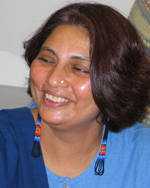Serendip is an independent site partnering with faculty at multiple colleges and universities around the world. Happy exploring!
Notes Towards Day 16: Homesick with Nowhere to Go?
Critical Feminist Studies:
"Homesick with Nowhere to Go"?
Hilary? Report on the dinner party?
4:00 today, with costumes: English Majors' Tea
For Tuesday: continue reading critical material,
this time on Chicana feminism:
Cherríe Moraga's 9 pp. "Breakdown of the Bicultural Mind" &
Paula M.L. Moya's 25 pp. piece about Moraga
we'll be joined by Tamarinda Figueroa and Ingrid Paredes,
Latinas/BMC students (respectively) in biology and poli sci
who took this course w/ me last fall, and whose critiques
multicultural, global, postcolonial...
On the relation between these first two sections of course
hpolak: " this piece...definitely has more of a clear feminist angle than some of the other literature we have been reading"Connection well-articulated by Sandra Lipsitz Bem
(as quoted by Leong):
historically and culturally created fictions [of sexual orientation, gender and race]...come to have psychological reality if they are institutionalized by the dominant culture....they can have extraordinary political power both for cultural oppression and for the resistance to cultural oppression.
speaking of which: some words about confidentiality
II. Random relevant event (from Transgender Task Force Mtg.)
single use and gender-neutral/flexible bathrooms
also: signage?

some alternatives....?

![]()
![]()

How abstract, how specific,
how evocative should/might these signs be?
More important than representation is
the question of how much effort we should put into
maintaining "urinary segregation."
(Thinking especially of religious strictures
on gender differentiation/separation/purity....)
-------
From the bathroom to the home....
-------
III. Biddy Martin and Chandra Talpade Mohanty
“Feminist Politics: What’s
Home Got to Do with It?”
| |
 |
The tension between the desire for home, for synchrony, for sameness, and the realization of the repressions and violence that make home, harmony, sameness imaginable...
...what distinguishes [our justification of the homogeneity of the women's community] from the justifications advanced by...the Klan for "family, community, and protection"?
"Identity: Skin, Blood, Heart"

Our guiding question today:
what is the relationship of home to
(feminist/any identity) politics?
What is its relation to the
process of learning, of education...
how essential is claiming our location
to the process of understanding--and acting?
"it's about ideas, not the people who have them,"
I've omitted names this time...)
--the fact that [Satrapi] has lived in Iran under the social and cultural pressures of the fundmentalist regime have given her a strong sense of self and the ability to stand up for what she believes in. These aspects of Satrapi's identity...firmly bound up in the notion of Iran as home....made me think of Bryn Mawr and our discussion of what it means to be a women's college today....This community is in large part based on the fact that it is single-sex...Does being a women's college make us exclusionary? is it a means of repression? Or is that fact...a way to combat repression?
--I like the phrase used by Martin and Mohanty: "Conceptualizing community differently without dismissing its appeal and importance."....a sociology professor [said] he hated community...a word that is all too quickly becoming trivialized.
--“well, you know, sometimes it’s just too much to keep in mind!"....Mohanty and Martin suggest that a better way to be politically effective than marginalization is a politics of intimacy, where connections are “made at levels other than abstract political interests”....Takagi is getting at something similar when she...says that...the fact that both of you are oppressed is not enough to guarantee effective dialogue....intimacy might be what is necessary....what creates a dialogue that isn’t based on categories, on people as objects, but on people as subjects, who are always something more than their given/taken categories.
---Having just finished Persepolis, I couldn't help but consider these critical essays in relation to the graphic novel....I was suprised that she did not explore her transition into a "sexual being"...particularly interesting considering the Iranian dresscode which requires women to conceal all signs of physical sexual development. I am curious about the body as a home for the self. Can the body be a home for the self if one does not have the freedom to expose it?
Countervoice of Edward Said, who argues in The World, the Text and the Critic (1983) for "travel as a habit of mind." Said uses Auerbach's project of Mimesis to illustrate the blindness of faithfulness/settledness, the importance of getting some distance/not having a commitment, in order to see clearly: this is an "ascetic code of willed homelessness," a procedure which allows you to think beyond the box/boundaries/commonsense, to theorize what is new...This privileges the concept of movement, of transition, an openness of mind facilitated by being "unsettled."
and Dana Takagi, "Maiden Voyage"
Asian American Sexualities
| |
|
Home bodies, homelands, homosexuals....This litany begins at home....But not homogeneous. Homegirls and homeboys. Where is home?
...worlds of Asian America and gay America separate places...sustained
by...the "family-centeredness and supra-homophobic beliefs of ethnic
communities." The doman of the Asian American "home" is usually kept
separate from the desire of the sexual and emotional "body."
The creation of same-sex communities and movements is not necessarily
tied to a single space, place, or even nation, but traversed and
determined by politics, migrations, lovers, and families across seas
and continents.
How 'bout we write for five minutes
(not to read aloud/share...
just for preparatory thinking....)
1) what is home for us?
2) what metaphors would we use to describe it?
3) what are the conditions on which our home is based?
4) on whose labor does our home depend?
Repeat again:
same questions w/ reference to Pratt
(see esp. pp. 196-197)
Repeat again:
same questions w/ reference to Leong and Takagi
(see esp. pp. 24-25)
Repeat again:
same question w/ reference to Satrapi
So (with reference to ourselves, Pratt, Leong, Takagi, Satrapi)...
1) what is home?
2) what metaphors do we have to describe it?
3) what are the conditions on which home is based?
4) on whose labor does home depend?
What is the relationship of home to
(feminist/any identity) politics?
What is its relation to the
process of learning, of education...
and political action?
Share our thoughts here, using Stephanie's guideline
(if you talk-while-thinking,count to 10 before doing so;
if you think-before-talking, count to 1 and SAY IT...)
-----
Some thoughts about those pauses....
Magda Lewis, Without a Word: Teaching Beyond Women's Silence: Reading silence as a discourse aimed at telling a different story, a counter-language that carries the full force of opposition to what has been said...
------
Reading Notes
from Martin/Mohanty/Pratt
power and appeal of "home" as a concept/desire
pursuit of safe places and ever-narrower conceptions of community
find ways of conceptualizing community differently
problematics of "home":
question conflation of experience, identity and political perspective
unsettle feminism as all-encompassing "home" and
assumption of discrete, coherent, separate identities
(notion of stable identity that conceals political stakes in that equation)
totalizing feminist discourse inadequate to situation of all women, including Western white women
constant reference to materiality of situation
(cf. indeterminacy which denies social situatedness):
politicizes geography, demography, architecture of Pratt's communities
"not being home": realizing it is an illusion of coherence and safety based on exclusion of specific histories of oppression and resistance
"growing up places" where Pratt's eye
"has only let in what I have been taught to see"
constant expansion of her "constricted eye"
fundamentally relational nature of identity
entrapment, constriction, bounded fortress
1) being "on the edge" on street in D.C.: different "speakings-to"
sense of constant movement, change, temporality
memory of safe, familiar southern home:
repressive space built on surrendered responsibility
2) being in clock tower of courthouse
lesbianism makes home impossible/self non-identical/vulnerable
privilege, comfort, home, secure notions of self purchased @ a price
complexity of father-daughter relationship
unity as potentially repressive ficiton
3) driving around the market house:
"vertigo" of learning of family history of racism, slaveholding
childish place secured by omission
from Leong/Takagi:
myth of Asian Americans as a...."model minority"..has worked against exploration into the varied nature of our sexual drives and gendered diversity..."gender non-conformists" have been met with silence
Many of us view ourselves as at the margins of both communities....the view is often clearest from the margins where "The split and contradictory self is the one who can interrogate positionings and be accountable."


